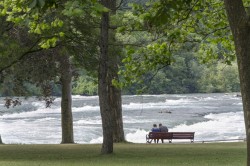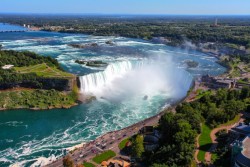A Quick Look at 3 of the Niagara River Islands
October 5, 2015 10:00 am When people stop to consider Niagara geography, it’s the massive waterfalls that always come first, followed by the Niagara River, the Niagara Gorge, and, maybe, Lake Erie.
When people stop to consider Niagara geography, it’s the massive waterfalls that always come first, followed by the Niagara River, the Niagara Gorge, and, maybe, Lake Erie.
While each of these is certainly notable in its own right, they are by no means the beginning and end of Niagara’s variable and ever-surprising landscape. Take, for instance, the many small islands that dot the Niagara River in and Niagara Falls, Ontario and Niagara, New York.
Many of them have fascinating features and interesting histories, and for the true explorer, they’re one more reason to visit Niagara. Here is a look at three of the many islands that populate the river out of which the mighty Niagara Falls plummet.
1. Goat Island
Named by John Stedman in the late 18th century, who claimed — somewhat dubiously — that the Seneca Native Americans had given them to him, Goat Island sits on the American side of things in the Niagara River right between the American and Canadian Falls. For a time, Stedman did keep goats on the island, but during a particularly harsh winter, he lost the entire herd save one.
The State of New York claimed the island in 1801 and tried to rename it Iris Island to no avail. The locals had become far too used to it being the site of Stedman’s goats to call it anything else, which is why it maintains the somewhat unappealing name to this day. Visitors to Goat Island can access it easily by a pedestrian bridge from the U.S. side.
2. Navy Island
 A 316-acre island located above the waterfalls on the Canadian side, the British established a Navy shipyard here in 1763 to combat what they considered to be a growing threat of Native American uprisings. Many different types of boats were built here over the years, such as sloops and schooners the British then used to explore the Great Lakes.
A 316-acre island located above the waterfalls on the Canadian side, the British established a Navy shipyard here in 1763 to combat what they considered to be a growing threat of Native American uprisings. Many different types of boats were built here over the years, such as sloops and schooners the British then used to explore the Great Lakes.
In 1837, Navy Island itself was the site of a rebellion, but Native Americans had nothing to do with. As many as 400 rebels — mostly disgruntled Americans of European ancestry — took over the island and the leader of the group, William Lyon Mackenzie, declared himself to be the Chief of State of the New Republic of Canada. The British bombarded the island but failed to fully prevail. A month later, the rebels moved their headquarters to Grand Island. Today, it is a wildlife preserve.
3. Grand Island
The largest island in the Niagara River, Grand Island is over 17,000 acres, and it was purchased by the state of New York from Native Americans in 1815. Land grants were then offered for free, but only about 150 people tried to make a home there. After ferry service was established in 1825, the East Boston Company bought roughly 16,000 of the acres for timber to sell for shipbuilding in Boston and New York. Bridges were completed to the island in the 1930s, and today, Grand Island has plenty to offer anyone visiting Niagara, including bowling, a small amusement park, and a golf course.
Don’t just stick to the beaten path the next time you come to the Niagara Falls area. Whether you do it for the history or for the fun, head out onto one of the islands that sit in the midst of the Niagara River.
Categories: Falls Avenue Resort
